Machine-Learning-Based Deformation Prediction Method for Deep Foundation-Pit Enclosure Structure
Abstract
1. Introduction
2. Dataset
2.1. Study Area
2.2. Samples Collection
2.3. Description of Deformation Characteristic Factors of the Foundation Pit
2.3.1. Impact of the Geological Environment
2.3.2. Impact of the Construction Progress
2.3.3. Impact of the Stress Monitoring Programs
2.3.4. Impact of the Displacement-Monitoring Results
2.4. Analysis of Dataset
3. Methodology
3.1. Data Preprocessing
3.2. Machine-Learning Methods
- Bootstrap sampling method:
- 2.
- Random selection of features:
- 3.
- Formation of diverse decision trees:
- Weak learners integration:
- 2.
- Sequential application:
3.3. Model Selection Methods
- First, the total sample was divided into k equal-sized subsets of samples;
- Second, these k subsets were sequentially traversed, with each iteration using the current subset as the validation set and all the remaining samples as the training set for model training and evaluation;
- Finally, the average of the k evaluation metrics was computed as the final evaluation.
3.4. Evaluation Metrics
4. Results and Discussion
4.1. Prediction Model Selection
4.2. Enclosure Deformation Prediction
4.3. Analysis of Feature Importance
4.4. Analysis of Factors Screening
4.5. Actual Predictions for Selected Monitoring Sites
5. Conclusions
Research Limitations
Author Contributions
Funding
Institutional Review Board Statement
Informed Consent Statement
Data Availability Statement
Conflicts of Interest
References
- Ning, Y.; Liu, S.G.; Zhao, S.Q.; Liu, M.C.; Gao, H.Q.; Gong, P. Urban growth rates, trajectories, and multi-dimensional disparities in China. Cities 2022, 126, 103717. [Google Scholar] [CrossRef]
- Jin, D.; Yuan, D.; Li, X.; Zheng, H. Analysis of the settlement of an existing tunnel induced by shield tunneling underneath. Tunn. Undergr. Space Technol. 2018, 81, 209–220. [Google Scholar] [CrossRef]
- Ramirez, R.A.A.; Lee, G.; Choi, S.; Kwon, T.; Kim, Y.; Ryu, H.; Kim, S.; Bae, B.; Hyun, C. Monitoring of construction-induced urban ground deformations using Sentinel-1 PS-InSAR: The case study of tunneling in Dangjin, Korea. Int. J. Appl. Earth Obs. Geoinf. 2022, 108, 102721. [Google Scholar] [CrossRef]
- Mahmoodzadeh, A.; Mohammadi, M.; Daraei, A.; Farid Hama Ali, H.; Kameran Al-Salihi, N.; Mohammed Dler Omer, R. Forecasting maximum surface settlement caused by urban tunneling. Autom. Constr. 2020, 120, 103375. [Google Scholar] [CrossRef]
- Pal, A.; Rošer, J.; Vulić, M. Surface Subsidence Prognosis above an Underground Longwall Excavation and Based on 3D Point Cloud Analysis. Minerals 2020, 10, 82. [Google Scholar] [CrossRef]
- De Caro, M.; Crosta, G.B.; Previati, A. Modelling the interference of underground structures with groundwater flow and remedial solutions in Milan. Eng. Geol. 2020, 272, 105652. [Google Scholar] [CrossRef]
- Li, X.; Zhou, T.; Wang, Y.; Han, J.; Wang, Y.; Tong, F.; Li, D.; Wen, J. Response Analysis of Deep Foundation Excavation and Dewatering on Surface Settlements. Adv. Civ. Eng. 2020, 2020, 8855839. [Google Scholar] [CrossRef]
- Ali, H.; Choi, J. Risk Prediction of Sinkhole Occurrence for Different Subsurface Soil Profiles due to Leakage from Underground Sewer and Water Pipelines. Sustainability 2020, 12, 310. [Google Scholar] [CrossRef]
- Plett, G.L. Adaptive inverse control of linear and nonlinear systems using dynamic neural networks. IEEE Trans. Neural Netw. 2003, 14, 360–376. [Google Scholar] [CrossRef] [PubMed]
- Sharghi, M.; Chakeri, H.; Ozcelik, Y. Investigation into the effects of two component grout properties on surface settlements. Tunn. Undergr. Space Technol. 2017, 63, 205–216. [Google Scholar] [CrossRef]
- Kim, D.; Kwon, K.; Pham, K.; Oh, J.; Choi, H. Surface settlement prediction for urban tunneling using machine learning algorithms with Bayesian optimization. Autom. Constr. 2022, 140, 104331. [Google Scholar] [CrossRef]
- Tang, L.; Na, S. Comparison of machine learning methods for ground settlement prediction with different tunneling datasets. J. Rock Mech. Geotech. Eng. 2021, 13, 1274–1289. [Google Scholar] [CrossRef]
- Cao, Y.; Zhou, X.; Yan, K. Deep Learning Neural Network Model for Tunnel Ground Surface Settlement Prediction Based on Sensor Data. Math. Probl. Eng. 2021, 2021, 9488892. [Google Scholar] [CrossRef]
- Mamat, R.C.; Ramli, A.; Omar, M.B.H.C.; Samad, A.M.; Sulaiman, S.A. Application of machine learning for predicting ground surface settlement beneath road embankments. Int. J. Nonlinear Anal. Appl. 2021, 12, 1025–1034. [Google Scholar] [CrossRef]
- Phoon, K.; Zhang, W. Future of machine learning in geotechnics. Georisk Assess. Manag. Risk Eng. Syst. Geohazards 2023, 17, 7–22. [Google Scholar] [CrossRef]
- Mitelman, A.; Urlainis, A. Investigation of Transfer Learning for Tunnel Support Design. Mathematics 2023, 11, 1623. [Google Scholar] [CrossRef]
- Mitelman, A.; Yang, B.; Urlainis, A.; Elmo, D. Coupling Geotechnical Numerical Analysis with Machine Learning for Observational Method Projects. Geosciences 2023, 13, 196. [Google Scholar] [CrossRef]
- Wang, Z. Numerical Analysis of Deformation Control of Deep Foundation Pit in Ulanqab City. Geotech. Geol. Eng. 2021, 39, 5325–5337. [Google Scholar] [CrossRef]
- Yang, J.; Kong, D. Deformation of deep and large foundation pit in soft soil of Fuzhou Subway. Arab. J. Geosci. 2020, 13, 36. [Google Scholar] [CrossRef]
- Li, H.; Zhao, Z.; Du, X. Research and Application of Deformation Prediction Model for Deep Foundation Pit Based on LSTM. Wirel. Commun. Mob. Comput. 2022, 2022, 9407999. [Google Scholar] [CrossRef]
- Ji, Z.; Wang, B.; Deng, S.; You, Z. Predicting dynamic deformation of retaining structure by LSSVR-based time series method. Neurocomputing 2014, 137, 165–172. [Google Scholar] [CrossRef]
- Sun, Y.Y.; Xiao, H.J. Wall Displacement and Ground-Surface Settlement Caused by Pit-in-Pit Foundation Pit in Soft Clays. Ksce J. Civ. Eng. 2021, 25, 1262–1275. [Google Scholar] [CrossRef]
- Lai, J.; Zhou, H.; Wang, K.; Qiu, J.; Wang, L.; Wang, J.; Feng, Z. Shield-driven induced ground surface and Ming Dynasty city wall settlement of Xi’an metro. Tunn. Undergr. Space Technol. 2020, 97, 103220. [Google Scholar] [CrossRef]
- Song, J.; Ye, G.L.; Xu, Y.F.; Sun, D.A. Numerical simulation of long-term settlement of structural soft soil subgrade considering consolidation history. Rock Soil Mech. 2018, 39, 1037–1046. [Google Scholar]
- Xue, L.Y.; He, C.K. Prediction algorithm for settlement amplitude of Taizhou’s building foundation. J. Discret. Math. Sci. Cryptogr. 2018, 21, 233–237. [Google Scholar] [CrossRef]
- Wu, M.X. Analysis of the influence of pile foundation settlement of high-rise buildings on surrounding buildings. Arab. J. Geosci. 2020, 13, 822. [Google Scholar] [CrossRef]
- Castro, J.; Karstunen, M.; Sivasithamparam, N. Influence of stone column installation on settlement reduction. Comput. Geotech. 2014, 59, 87–97. [Google Scholar] [CrossRef]
- Tran, Q.H.; Nguyen, H.; Bui, X.N. Novel Soft ComputingModel for Predicting Blast-Induced Ground Vibration in Open-Pit Mines Based on the Bagging and Sibling of Extra Trees Models. CMES-Comp. Model. Eng. Sci. 2023, 134, 2227–2246. [Google Scholar]
- Schonlau, M.; Zou, R.Y. The random forest algorithm for statistical learning. Stata J. 2020, 20, 3–29. [Google Scholar] [CrossRef]
- Li, X.Y.; Li, W.D.; Xu, Y. Human Age Prediction Based on DNA Methylation Using a Gradient Boosting Regressor. Genes 2018, 9, 424. [Google Scholar] [CrossRef]
- Luo, H.R.; Cheng, F.; Yu, H.; Yi, Y.Q. SDTR: Soft Decision Tree Regressor for Tabular Data. IEEE Access 2021, 9, 55999–56011. [Google Scholar] [CrossRef]
- Ben Jabeur, S.; Gharib, C.; Mefteh-Wali, S.; Ben Arfi, W. CatBoost model and artificial intelligence techniques for corporate failure prediction. Technol. Forecast. Soc. Chang. 2021, 166, 120658. [Google Scholar] [CrossRef]
- Dutt, M.I.; Saadeh, W. A Multilayer Perceptron (MLP) Regressor Network for Monitoring the Depth of Anesthesia. In Proceedings of the 2022 20th IEEE Interregional NEWCAS Conference (NEWCAS), Quebec City, QC, Canada, 19–22 June 2022; pp. 251–255. [Google Scholar]
- Quinlan, J.R. Induction of Decision Trees. Mach. Learn. 1986, 1, 81–106. [Google Scholar] [CrossRef]
- Geurts, P.; Ernst, D.; Wehenkel, L. Extremely randomized trees. Mach. Learn. 2006, 63, 3–42. [Google Scholar] [CrossRef]
- Breiman, L. Random Forests. Mach. Learn. 2001, 45, 5–32. [Google Scholar] [CrossRef]
- Hoang, N.; Thanh, V.; Vo, T.P.; Huu-Tai, T. Efficient machine learning models for prediction of concrete strengths. Constr. Build. Mater. 2021, 266, 120950. [Google Scholar] [CrossRef]
- Manzoor, U.; Ehsan, M.; Radwan, A.E.; Hussain, M.; Iftikhar, M.K.; Arshad, F. Seismic driven reservoir classification using advanced machine learning algorithms: A case study from the Lower Ranikot/Khadro sandstone gas reservoir, Kirthar Fold Belt, Lower Indus Basin, Pakistan. Geoenergy Sci. Eng. 2023, 222, 211451. [Google Scholar] [CrossRef]
- Ostroumova, L.; Gusev, G.; Vorobev, A.; Dorogush, A.V.; Gulin, A. CatBoost: Unbiased boosting with categorical features. In Proceedings of the 31st International Conference on Neural Information Processing Systems, Long Beach, CA, USA, 4–9 December 2017. [Google Scholar]
- Chen, T.; Guestrin, C. XGBoost: A Scalable Tree Boosting System. In Proceedings of the 22nd ACM SIGKDD International Conference on Knowledge Discovery and Data Mining, San Francisco, CA, USA, 13–17 August 2016. [Google Scholar]
- Ke, G.; Meng, Q.; Finley, T.; Wang, T.; Chen, W.; Ma, W.; Ye, Q.; Liu, T. LightGBM: A Highly Efficient Gradient Boosting Decision Tree. In Proceedings of the 31st International Conference on Neural Information Processing Systems, Long Beach, CA, USA, 4–9 December 2017. [Google Scholar]
- Friedman, J.H. Greedy function approximation: A gradient boosting machine. Ann. Stat. 2001, 29, 1189–1232. [Google Scholar] [CrossRef]
- Duarte, E.; Wainer, J. Empirical comparison of cross-validation and internal metrics for tuning SVM hyperparameters. Pattern Recognit. Lett. 2017, 88, 6–11. [Google Scholar] [CrossRef]
- Zhou, J.; Shi, X.Z.; Du, K.; Qiu, X.Y.; Li, X.B.; Mitri, H.S. Feasibility of Random-Forest Approach for Prediction of Ground Settlements Induced by the Construction of a Shield-Driven Tunnel. Int. J. Geomech. 2017, 17, 04016129. [Google Scholar] [CrossRef]
- Averko, Z.; Vrankić, M.; Vlahinić, S.; Rogelj, P. Complex Pearson Correlation Coefficient for EEG Connectivity Analysis. Sensors 2022, 22, 1477. [Google Scholar]
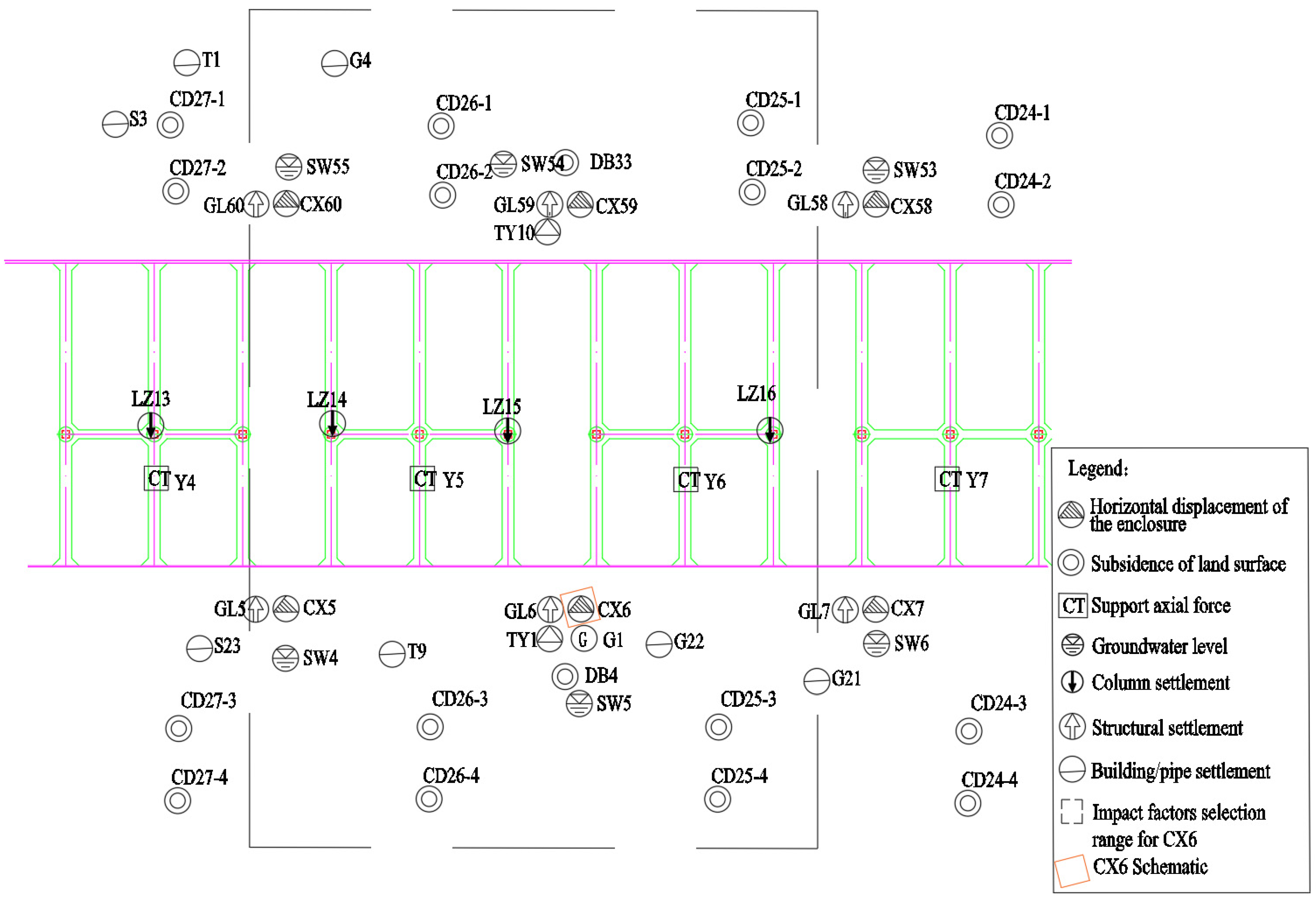

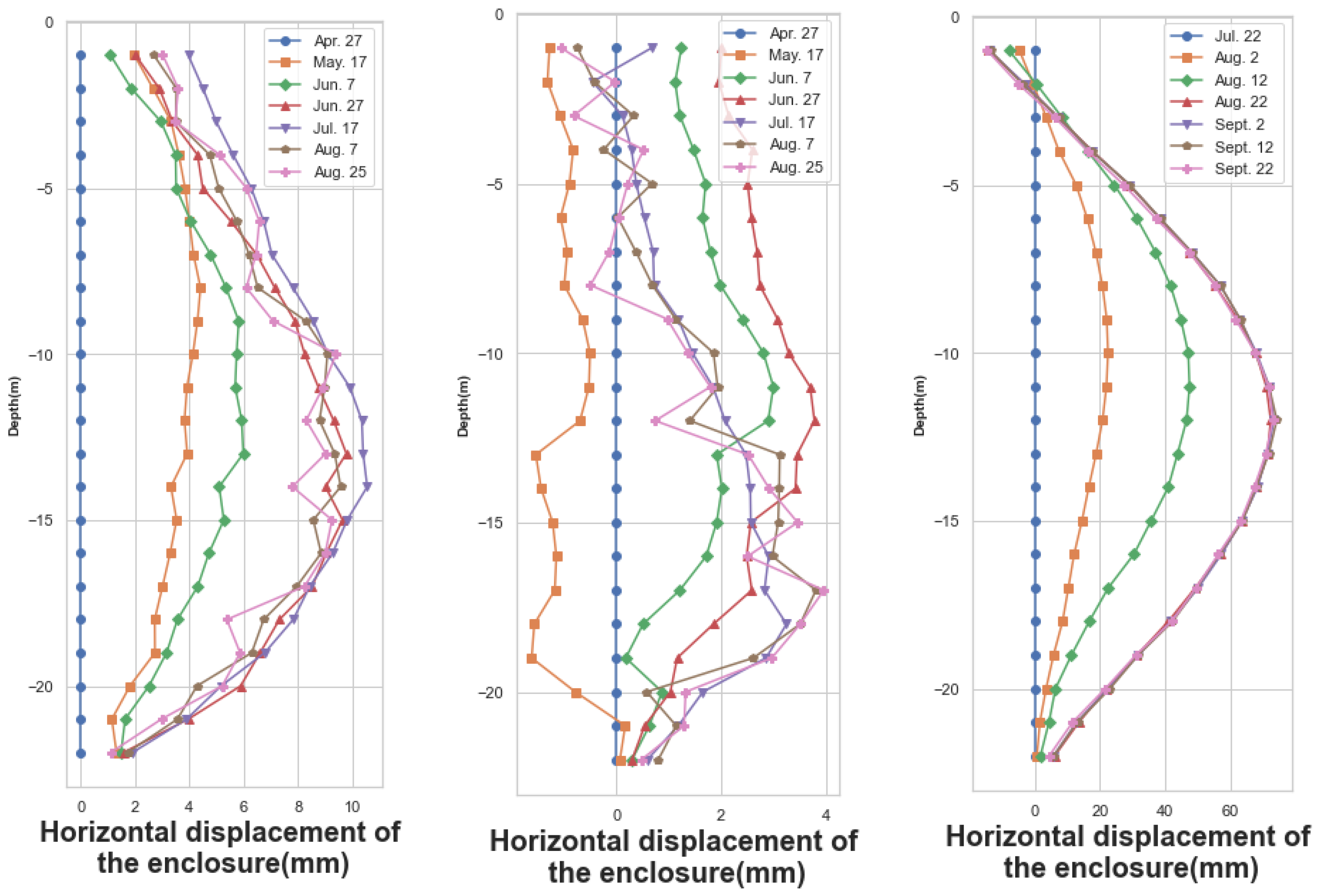
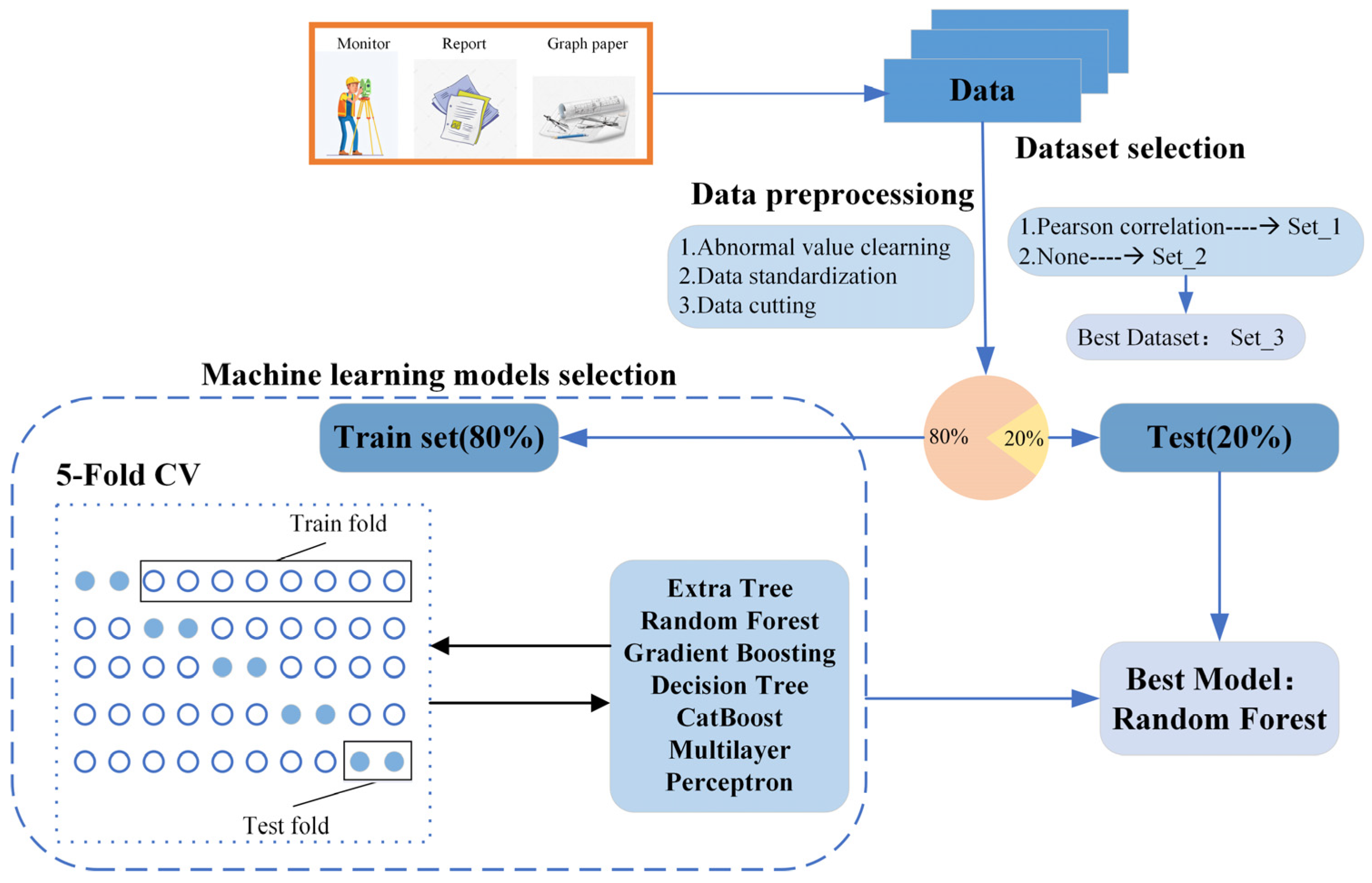
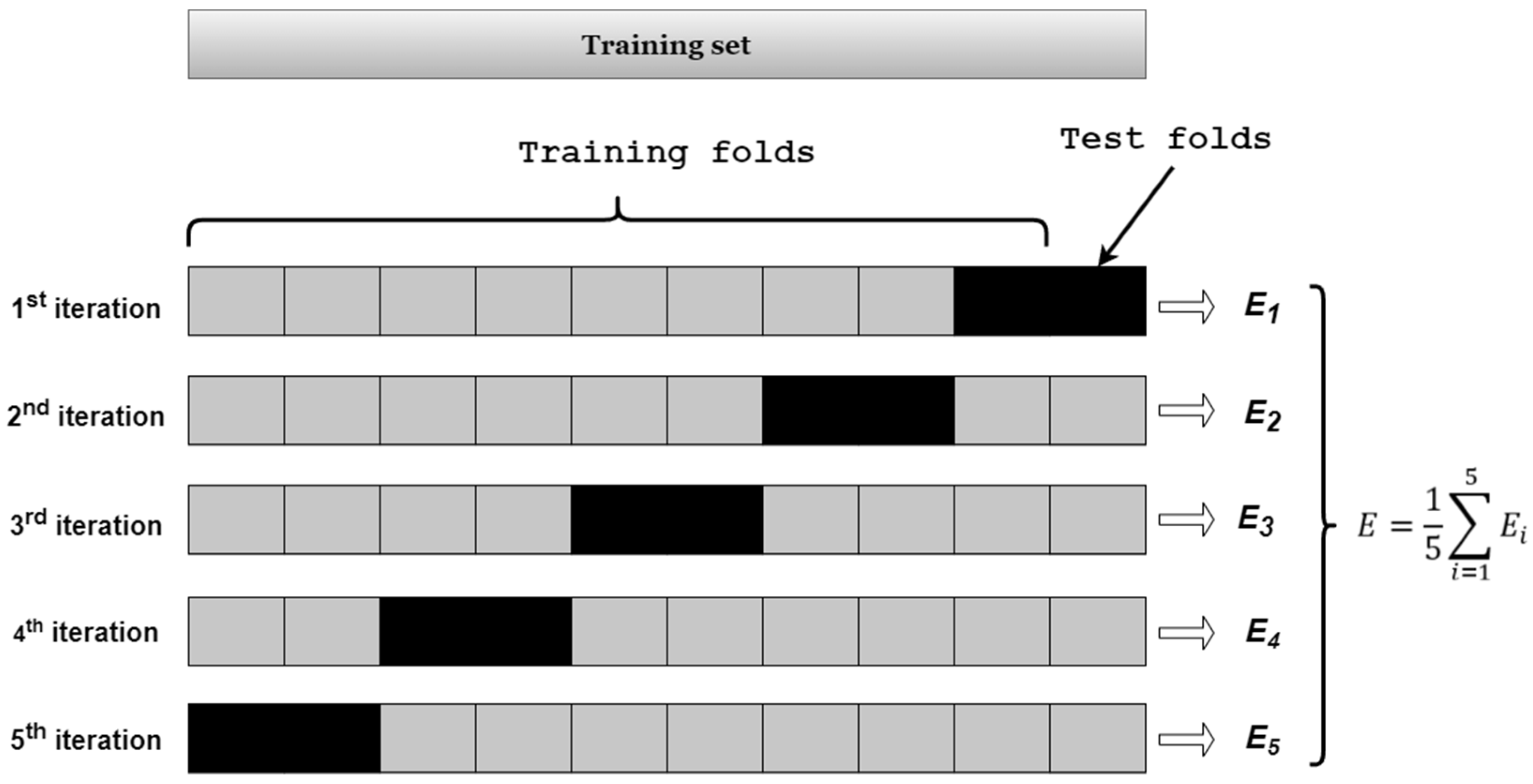

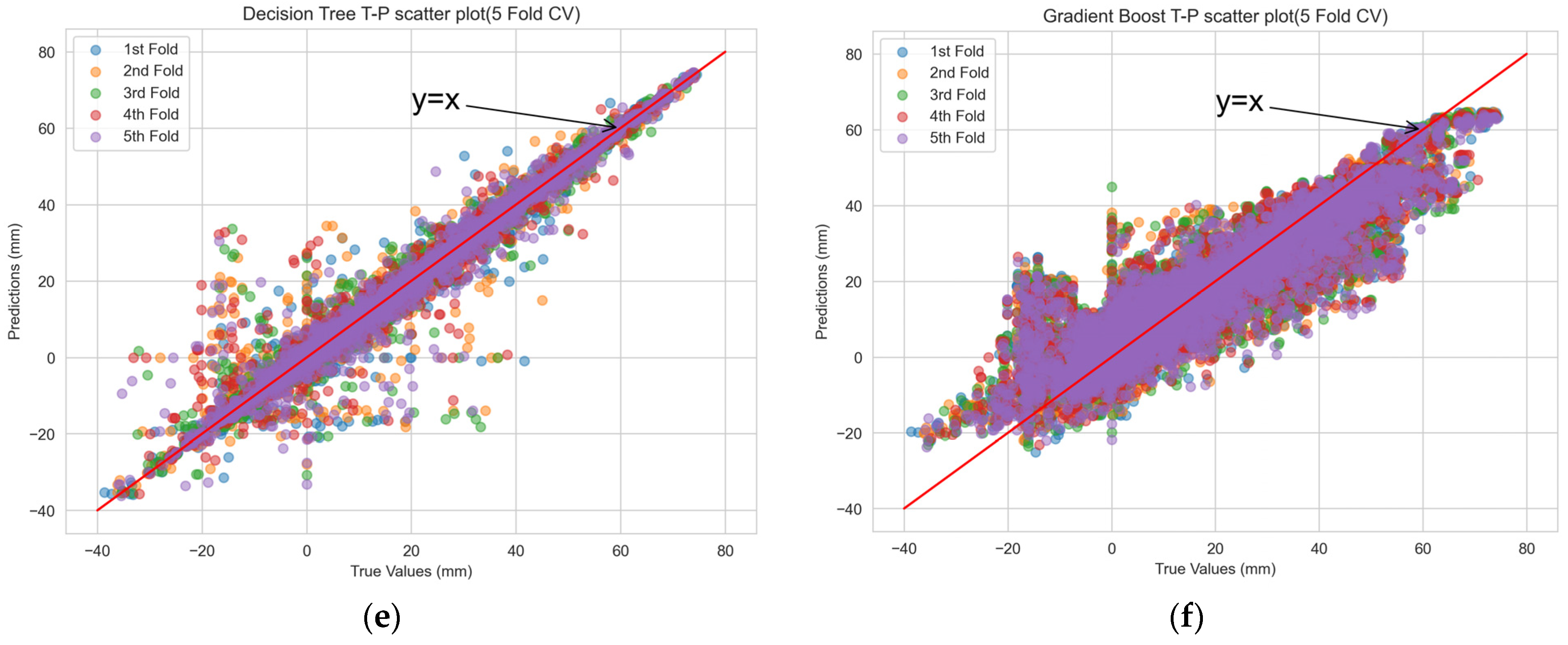


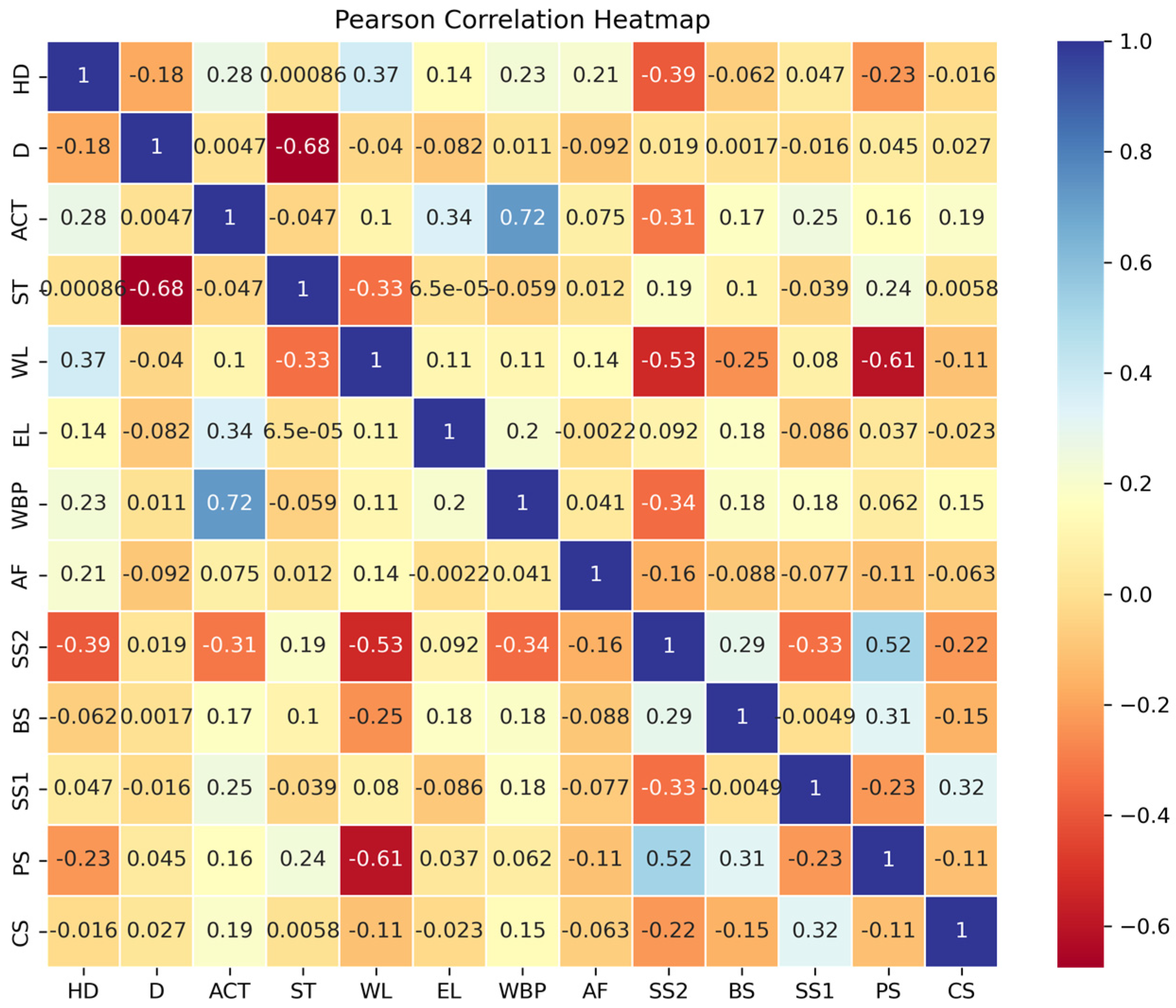

| Category | Impact Factor | Descriptive | Unit |
|---|---|---|---|
| Target value | Horizontal displacement (HD) | Individual inclinometers and slope values at different depths. | mm |
| Dynamic characterization factors | Airline cumulative time (ACT) | The exposure time of the foundation-pit floor slab, from excavation start to slab-pouring end. | day |
| Excavated Length (EL) | The overall length of the foundation-pit excavation at the time of the count was determined from the weekly construction reports. | m | |
| Whether the bottom plate is poured (WBP) | Whether the silo housing the current tilt point has a poured footing. | 0 for unpoured; 1 represents the completion of the pour. | |
| Axial force (AF) | Support axial force. | kN | |
| Building settlement (BS) | Settlement of buildings around the main structure of the station. | mm | |
| Pipeline settlement (PS) | Pipe subsidence caused by excavation in the subway project. | mm | |
| Structural settlement (SS1) | Sinking of sections or structures during subway construction. | mm | |
| Column settlement (CS) | Columns in buildings such as subway stations sank during the construction. | mm | |
| Surface settlement (SS2) | Surface-settlement values obtained from the monitoring point. | mm | |
| Water level (WL) | Presence of groundwater at different depths. | mm | |
| Static characterization factors | Soil type (ST) | Identification of geotechnical types. | 1: Plain fill; 2: Clay; 3: Strongly weathered muddy sandstone, 4: Moderately weathered muddy sandstone. |
| Depth (D) | Monitoring Depth | m |
| Factor | Avg. | Std. | Min. | Max. | 25% | 50% | 75% |
|---|---|---|---|---|---|---|---|
| HD (mm) | 13.85 | 19.82 | −38.67 | 74.58 | 0.21 | 6.37 | 26.99 |
| D (m) | −11.49 | 6.45 | −24 | −1 | −17 | −11 | −6 |
| ACT (day) | 5.76 | 7.04 | 0 | 22 | 0 | 0 | 13 |
| ST | 1.99 | 0.68 | 1 | 4 | 2 | 2 | 2 |
| WL (mm) | −31,709.3 | 588.75 | −32,734 | −31,071 | −32,172 | −31,456 | −31,309 |
| EL (mm) | 421,114 | 303,140 | 232,410 | 2,735,224 | 232,410 | 352,410 | 479,946 |
| WBP | 0.33 | 0.47 | 0 | 1 | 0 | 0 | 1 |
| AF (KN) | 457.68 | 1519.62 | −122.71 | 17,518.1 | 0 | 0 | 467.5 |
| SS2 (mm) | −14.85 | 12.49 | −29.15 | 6 | −27.23 | −17 | −0.57 |
| BS (mm) | −0.99 | 3.94 | −12.43 | 9.82 | −3.55 | −0.69 | 1.33 |
| SS1 (mm) | 2.34 | 2.68 | −3.33 | 10.12 | 0 | 1.97 | 4.27 |
| PS (mm) | −13.22 | 14.9 | −28.99 | 20.07 | −27.4 | −17.33 | 0.79 |
| CS (mm) | 1.04 | 2.11 | −5.43 | 0 | 0 | 2.0 | 13.98 |
| No. | Machine-Learning Algorithms | Clarification |
|---|---|---|
| 1 | Extra tree Regressor [28] | A regressor with multiple highly randomized decision trees and limited to integration methods. |
| 2 | Random Forest (RF) Regressor [29] | The algorithm builds multiple decision trees by random sampling and averages the results of all the trees to obtain an overall prediction. |
| 3 | Gradient Boosting Regressor [30] | An algorithm for combining multiple simple models into a composite model. |
| 4 | Decision Tree (DT) Regressor [31] | A method for approximating the value of a discrete function. Generalization is used to generate readable rules and decision trees, and decision making is used to analyze new data. |
| 5 | CatBoost Regressor [32] | Asymmetric decision tree-based algorithm that can effectively and rationally handle categorization features. |
| 6 | Multilayer Perceptron (MLP) Regressor [33] | A feed-forward neural network comprising a plurality of neuron layers forming a fully connected structure between the layers. |
| Model | MAE (mm) | RMSE (mm) | |
|---|---|---|---|
| RF | 0.9909 | 0.8581 | 1.8970 |
| CB | 0.9820 | 1.7913 | 2.6642 |
| ET | 0.9500 | 1.4448 | 4.3536 |
| GB | 0.8373 | 5.5417 | 8.0098 |
| DT | 0.9785 | 1.0482 | 2.9032 |
| MLP | 0.9512 | 2.5083 | 4.3831 |
| Statistical Results of Significance | MAE (mm) | RMSE (mm) | |
|---|---|---|---|
| Random Forest Prediction Model | 0.9905 | 0.8572 | 1.9119 |
| Dataset | Target Value | Characteristic Factor |
|---|---|---|
| Set_1 | HD | D, ACT, EL, WBP, AF, SS1, SS2, PS; |
| Set_2 | HD | D, ACT, WL, EL, WBP, AF, SS2, SS1, PS, ST, BS, CS; |
| Feature Selection | Dataset | 5-Fold Cross Validation | Test Set | ||||
|---|---|---|---|---|---|---|---|
| MAE | RMSE | MAE | RMSE | ||||
| Pearson | Set_1 | 0.9746 | 1.5108 | 3.1614 | 0.9734 | 1.5093 | 3.1987 |
| None | Set_2 | 0.9907 | 0.8629 | 1.9165 | 0.9905 | 0.8621 | 1.9156 |
| Assessment Indicators | RMSE (mm) | MAE (mm) | |
|---|---|---|---|
| Prediction of CX1&CX58 | 0.9646 | 3.6403 | 0.5625 |
Disclaimer/Publisher’s Note: The statements, opinions and data contained in all publications are solely those of the individual author(s) and contributor(s) and not of MDPI and/or the editor(s). MDPI and/or the editor(s) disclaim responsibility for any injury to people or property resulting from any ideas, methods, instructions or products referred to in the content. |
© 2024 by the authors. Licensee MDPI, Basel, Switzerland. This article is an open access article distributed under the terms and conditions of the Creative Commons Attribution (CC BY) license (https://creativecommons.org/licenses/by/4.0/).
Share and Cite
Xu, Y.; Zhao, Y.; Jiang, Q.; Sun, J.; Tian, C.; Jiang, W. Machine-Learning-Based Deformation Prediction Method for Deep Foundation-Pit Enclosure Structure. Appl. Sci. 2024, 14, 1273. https://doi.org/10.3390/app14031273
Xu Y, Zhao Y, Jiang Q, Sun J, Tian C, Jiang W. Machine-Learning-Based Deformation Prediction Method for Deep Foundation-Pit Enclosure Structure. Applied Sciences. 2024; 14(3):1273. https://doi.org/10.3390/app14031273
Chicago/Turabian StyleXu, Yangqing, Yuxiang Zhao, Qiangqiang Jiang, Jie Sun, Chengxin Tian, and Wei Jiang. 2024. "Machine-Learning-Based Deformation Prediction Method for Deep Foundation-Pit Enclosure Structure" Applied Sciences 14, no. 3: 1273. https://doi.org/10.3390/app14031273
APA StyleXu, Y., Zhao, Y., Jiang, Q., Sun, J., Tian, C., & Jiang, W. (2024). Machine-Learning-Based Deformation Prediction Method for Deep Foundation-Pit Enclosure Structure. Applied Sciences, 14(3), 1273. https://doi.org/10.3390/app14031273






